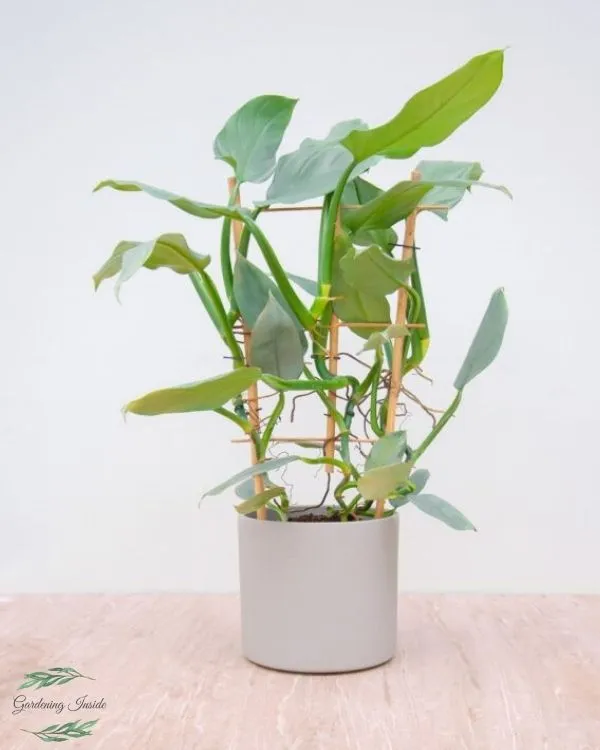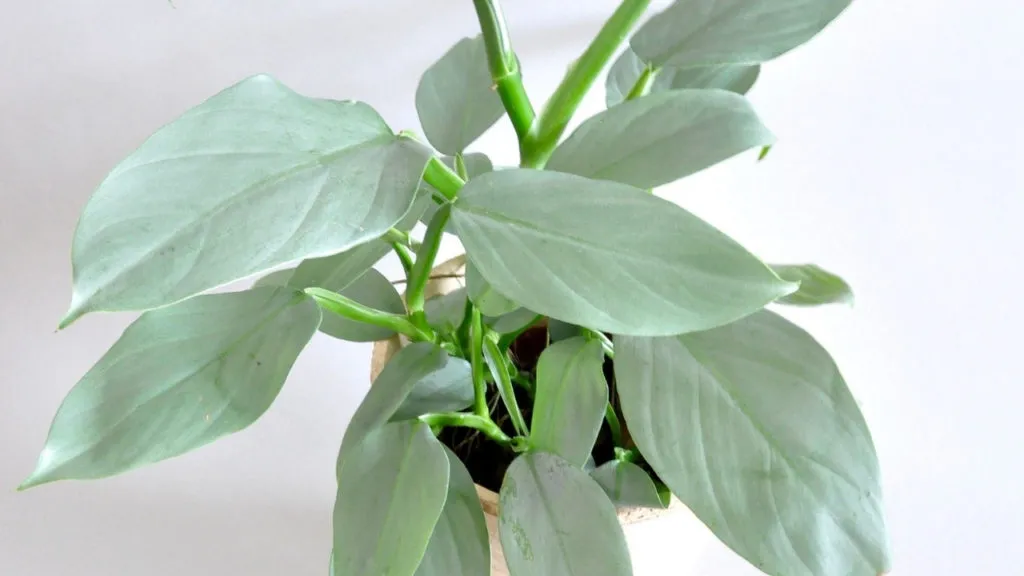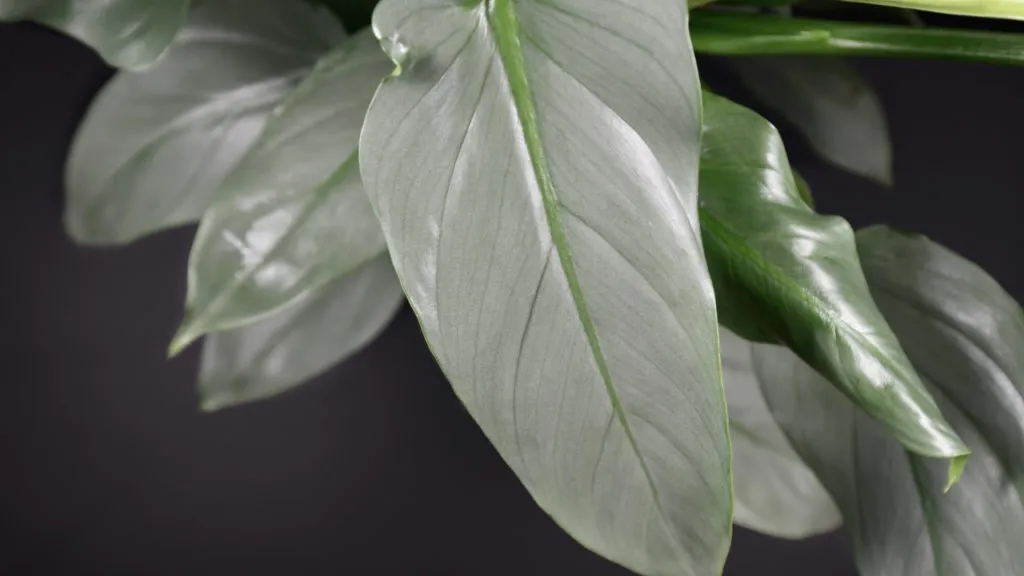The philodendron family contains a lot of mesmerizing and appealing plants that will blow your mind. This amazing philodendron hastatum, also known as the silver sword, has a beautiful appearance to attract viewers’ attention. It is the easiest plant to care for in the philodendron family and has a prolific growth rate.
Do you love to grow plants with a fast growth rate? Then do not go anywhere; philodendron hastatum is the perfect choice of yours.
Philodendron hastatum is a forgiving plant and can bear your minor negligence. It has a robust nature and is famous for its urban jungle beauty. The sword-like leaves of the plant create a beautiful look, and it can grow up into the braid as well.
If you decide to grow philodendron hastatum at your place, then this guide will help you take care of your plant.

Philodendron Hastatum – The Real Climber
- Philodendron hastatum is native to South America and the Caribbean and loves to grow in rain forests.
- Naturally, this plant feels comfortable growing under the shade of large trees and has a climbing nature.
- It is known to be a natural climber due to which it climbs over the tree trunks to get sunlight. So, you can say both of them are mates of each other.
- The stems of philodendron hastatum are thick enough to help it quickly climb on the tree trunk.
Philodendron Hastatum Characteristics
- The leaves of the plant are silver grey-green, due to which it got the name of Silver Sword.
- Philodendron hastatum has a silver-grey glow on the leaves, due to which they appear to be shiny.
- You need to maintain the brilliance of these leaves by avoiding contact with direct sunlight. Morning light will be enough for its growth.
- The plant loves to grow in a moderate amount of water with small portions. Also, the soil must be slightly moist in summers and spring.
- Water the plant once a week, and it will be perfect for its growth. It will also help the plant to prevent pests or root rot.
- One of the fantastic features of this plant is that it shows sustainable development with sword-like lush green leaves.
- Growers also prefer to grow this plant indoors due to its air purification feature.
Best Philodendron Hastatum Care
This section will guide you about philodendron hastatum care. The following are some instructions that you need to follow for the maintenance:

Also Check: String of Turtles (Peperomia Prostrata) Care & Propagation
Pitch of the Plant:
Philodendron hastatum grows naturally under the shade of large trees, as they do not love to grow in direct sunlight. Partial shade contributes to the prolific growth rate of the plant.
So, if you are growing this plant indoors, make sure to place your plant in the area of partial shade. While outdoors, put it in the corner of your garden where the shadow is present.
If the plant catches direct sunlight, it can result in stunt growth, and the leaves of the plant turn out to be yellow or brown.
Watering Preferences:
The good news is, philodendron hastatum can bear a bit of negligence. The optimum amount of water is perfect for the growth of philodendron hastatum. This plant is relatively strong and can handle too much or too little water without damaging the plant.
Just remember to water the plant in a moderate amount and ensure that the soil does not get too much dry. The amount of water gets reduced in winters, and these plants need more water on sunny days of summer.
Spraying – Humidity Maintenance:
Philodendron hastatum loves growing in humidity, as they are tropical. You need to provide the plant with little attention in this case.
Also, make sure to maintain the humidity level in dry weather conditions. Using a humidifier will help in the maintenance of the humidity level.
Negligence in fulfilling the humidity level can result in yellowing of the leaves. It can also cause stunt growth of your beautiful philodendron hastatum.
The Soil of the Plant:
You need to maintain the consistency of soil for the perfect growth of philodendron hastatum. The soil in which these plants love to grow is loose and well-draining soil. It will help the plant to grow well.
Temperature:
Philodendron hastatum does not love to grow in direct sunlight, as it can impact the plant’s growth. The ideal temperature of philodendron hastatum is between 18 to 25 degrees.
Toxicity:
The nature of philodendron hastatum is toxic, due to which you must take care of your pets and children. Intake of this plant can impact the health of the plant.
Fertilizer:
The all-purpose liquid is a perfect fertilizer to let your philodendron hastatum grow well. This will promote the ideal growth of the plant.
You need to maintain the amount of fertilizer, and if the leaves of your plant are turning yellow, then it is an indication that your plant has less calcium or magnesium.
Philodendron Hastatum Propagation
You can propagate your silver sword by using stem cuttings. Utilizing these stem cuttings will help in the propagation of the plant. Placing these stem cuttings in water or soil can help in the growth.
Moreover, you must wear gloves or wash your hands before cutting the stems.
Potting:
You need to check the stem cuttings, and if there are any roots, you must place them in potting. The pot must have drainage holes, as it will prevent the soil from becoming too wet.
Buy a pot that has the perfect size to let these plants grow well. Also, using round pots is optimum for philodendron‘s growth and propagation.
Potential problems faced by Philodendron Hastatum Plant
One of the common problems faced by philodendron hastatum is the discoloration of the leaves. Lack of maintenance of these plants can cause these issues; therefore, you need to care for the plant.
Browning of the leaves is due to the over-watering of the plants. While if too much sunlight is present, then it results in yellowing of the leaves. Make sure you need to provide the plant with optimum care and growth conditions.

You May Also Like: Hoya Retusa Plant Care | Grass Leafed Hoya | Propagation Guide
Philodendron Hastatum Growth
The growth of the silver sword is relatively fast and is a natural climber. If this plant is attached to bamboo or moss sticks, it can help in the proper growth of the plant. You can also hang the plant in baskets indoors.
Re-potting:
Re-potting will help in the proper maintenance of the plant. You must ensure to check the plant’s roots, and if it is filled with roots, you must upgrade the pot size. Boosting the pot size will promote growth.
Conclusion:
Philodendron hastatum is an easy-to-handle plant and requires low maintenance. You need to maintain the growing conditions of the plant to make it look glamorous and powerful. Remember to provide the plant with the optimum amount of water and sunlight. It will help in the prolific growth of the plant.
You can quickly propagate the plant using stem cuttings, and adding this to your garden bed will be a perfect decision. It is an artificial humidifier and can be an ideal plant friend of yours.
So, make your plant happy by providing it with optimum growing conditions. Happy Growing!
Frequently Asked Questions about Philodendron Hastatum
How big does a Philodendron Hastatum get?
The average height of the plant is 3 meters and can also increase to more than 3 meters.
How often do I need to water it?
Philodendron hastatum can bear a bit of negligence in the watering. Check the top 2 to 3 inches of the soil before watering the plant. Also, do not over-water the plant.
How do you propagate philodendron hastatum?
You can quickly propagate the plant by using stem cuttings. Just cut the plant having nodes on it. After that place, these nodes in water and wait for some time. Roots will appear on the stem cuttings, which is the right time to propagate in the soil.
Why is my philodendron yellow?
The two primary reasons for the yellowing of the plants are improper soil and overwatering. Slight negligence and alternations in the plant can cause yellowing of the leaves.
Is silver philodendron rare?
Yes, this philodendron is a rare and unusual plant. The plant has metallic-looking foliage and is perfect for adding to your landscape. It has a climbing habit, and you can also grow it in a hanging basket. Overall, the philodendron has an endangered species.
